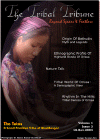Tribal World of Orissa: A Demographic View
|
Distribution There are 62 aboriginal communities in Orissa, who are recognized as scheduled tribes. These are people form 22.13% of total population of Orissa, as per 2001 census. They are 24.61% of the rural and 8.10% of urban population of the State. Numerically they count 8,145,081 of which there are 4,066,783 males 4,078,298 females. Sex ratio (expressed as number of females per one thousand males) is estimated as 1002.8. The tribal people are mostly (7,698,358) rural inhabitants. Their core habitat areas are much away from towns and situated in the hilly forest land. The minority of them (4,46,723) who are found in the urban areas are all migrants from natal villages. Except some tribal persons, who are highly educated and have white-collar jobs in the public/private sectors, majority urban dwellers are daily wage earners and live in slums. The tribal communities once formed the basic substratum of Indian population. Existence of tribal kingdoms in Orissa has been found in the edicts of Ashoka in pre-Christian era. Through various historical processes, the tribal people were relegated to the infertile hilly terrain and there they lived within natural surrounding enjoying their community autonomy. In this way, they missed the flow of development process of other communities. Today they require legislation to protect their rights and receive packages of various measures of development. Present Orissa has 30 administrative districts, but earlier census records (up to 1991) show 13 districts. The coastal districts are less mountainous with thin forest coverage. So, concentration of the tribal is less. The central, western and northern districts provide ideal habitation of tribal population due to geo-environmental conditions. The district Malkanagiri, bordering Andra Pradesh and Chhattisgarh on the Eastern Ghats, shows highest (57.4% of total tribal population) concentration of tribal people. On the other hand, Kendrapara district (on the sea coast), shows lowest( 0.52% of tribal population) concentration. The other hilly areas in the districts of Keonjhar, Sundargarh, Mayurbhanj, Khandamala, Gajapati, Dhenkanal, etc have fair concentration of various tribal communities. National Family Health (NFH) survey conducted between 1998-99 on selected samples of tribal areas of Orissa, revealed some valuable information. Illiteracy is very high, especially among women. About 90% of ever-married women can not read and write, 65% are not exposed to any media and only 10% of such women have occasional exposure to radio or television. The tribal communities living in their natural habitat do not keep track of age. They go into wedlock when the boys become young adult, capable of taking care of their wives and the girls grow up to physical maturity, able to bear child and look after domestic aspect. In general the girls are married off between 15 to16 years and normally do not remain unmarried at 20 years. The median age of first pregnancy is 18.8 years. Tribal women between 15-49 years (total reproductive career), have mean number of children ever born as 4.28, whereas the total fertility rate (TFR) per women is 2.06. This is lower than the rate observed among scheduled caste women. The gap between two births is appreciably (33 months), as they do not want to get a baby before weaning of the previous child.
Due to campaign of birth control, the younger women (more than 50%) do not want to have more children. 38% of women have accepted reproduction control method of any type. Tubectomy (sterilization of women) is accepted by more than 25% of married women. Still, the adoption of modern methods of birth control is lower than non-tribal people. Survival of tribal children is very low due to various reasons. Undernourished mothers not attended by qualified midwives, suffered at childbirth. Under-weight babies are less likely to survive and those infant mortality rate (IMR) among tribal babies is 99 per 1000 births; child mortality (between 1 year to les than 5 years) is 44 per 1000 children. Government effort for reaching out to the tribal people for providing immunization facilities is not yet very successful . Only 26.4% of the children received all doses and 18% have not received any sort of immunization. 30.5% children received only one dose of vitamin A. Chronic Energy Deficiency (CED) of tribal women is observed to be as high as 55.5% and 75% of tribal women have been found to be anemic. These are very alarming. Breast-feeding is wide spread. But squeezing first milk (colostrums) from breast is very high (72.5%). This practice is customary. Considered by measures of body weight for age, and height for age, majority of tribal children are victims of grades of under-nutrition and stunting. This finding is also supported by measure of weight for height. The Severity of these deprivation related health disorders among the tribal people have been observed to be: Weight for age as 26.5%; Height for age as 19.9% ; Weight for height as 5.7%; Anemia of children 83.9%.The following data reveal health care measures received by the tribal people of Orissa:
The tribal people are accustomed to traditional knowledge perpetuated through generations. Modern medical aid even though available nearby, is not tried by many. The health service providers have obtained the present statistical picture after long efforts. It is a hard task to provide sufficient healthy food, education and modern way of treatment to the deprived tribal people living in inaccessible areas of Orissa.
|
Photographs : Bonda Kids - Ramesh Prasad Mohanty




